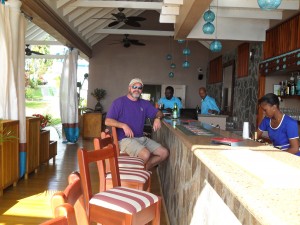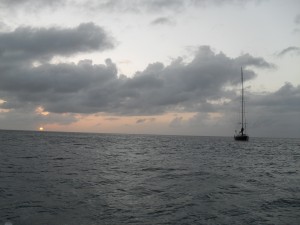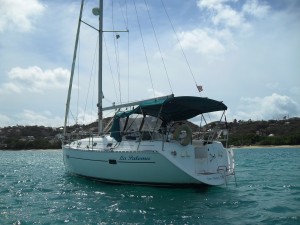Sailing St. Vincent and the Grenadines, Part 1
The La Paloma
Ok, I haven’t posted for a while but I’m finally catching up with this first part of our sailing trip around St. Vincent and the Grenadines. Shelly and I did a bareboat charter (just the two of us) and had some challenging sailing in the southern Caribbean.
We flew out of Denver just as one of the larger snowstorms of the year was developing. Landed in Grenada and stayed overnight. You remember Grenada, the little country that Reagan had the military invade in 1983. This small island must have been completely overwhelmed by that action and the point was made, like pushing in a thumb tack with a sledge hammer. Anyway, it was a beautiful place, what little we saw before island hopping to St. Vincent the next morning.
We had the next entire day to hang out in St. Vincent . We stayed at the Beachcombers Hotel right on the beach. Nice place with an outdoor bar where you could grab a beer and watch the sailboats cruise in what appeared to be a calm sea just offshore, which I am doing in the pic on the right. The local St. Vincent beer is called Hairoun, which happens to be the native Carib name for St. Vincent. It means “land of the blessed.” That might well be a true saying, but unfortunately they haven’t been blessed enough to bottle their beer in 12-ounce size. Each Hairoun was in an 8-ounce bottle. You have to order Presidente beer to get your 12-ounce size. And the price is about the same. Go figure. And truth be told, Presidente is better beer (disclaimer: Do not, under any circumstances, take my recommendations as to what makes a good beer. If you do, you will likely be severely disappointed and develop deep anger and resentment).
. We stayed at the Beachcombers Hotel right on the beach. Nice place with an outdoor bar where you could grab a beer and watch the sailboats cruise in what appeared to be a calm sea just offshore, which I am doing in the pic on the right. The local St. Vincent beer is called Hairoun, which happens to be the native Carib name for St. Vincent. It means “land of the blessed.” That might well be a true saying, but unfortunately they haven’t been blessed enough to bottle their beer in 12-ounce size. Each Hairoun was in an 8-ounce bottle. You have to order Presidente beer to get your 12-ounce size. And the price is about the same. Go figure. And truth be told, Presidente is better beer (disclaimer: Do not, under any circumstances, take my recommendations as to what makes a good beer. If you do, you will likely be severely disappointed and develop deep anger and resentment).
The next day proved to be an adventure. We showed up at the charter office around 9 am but the boat wasn’t ready. The jib sail (the one in front) was being repaired and the engine was having issues. They replaced the coolant pump. By the time we could get sailing it was almost 3 pm, pretty late. We needed to get to Bequia, the nearest island, which could take more than a couple of hours.
We discovered that our boat, the La Paloma, had a main sail that furled in and out of the mast. The usual rigging for the main sail on a mono-hull boat is to raise and lower the sail using a rope called a halyard, so when you want to sail you raise the mainsail and when you want to stop sailing you drop the main down to the boom. If you look at the diagram below, our sail rolled left and right into and out of the mast, while most mono-hulls have the main sail go up and down from the boom. This was new to us but it seemed way more convenient.

NOT! The last thing the charter guys said to us as we were leaving was that “sometimes the sail sticks” and you have to go up on deck to pull the sail out of the mast. What he meant was that it always gets stuck and you have to go out and heave mightily on the damn thing every time you unfurl it. We didn’t think much of it at the time, but it turned into a major difficulty. And keep in mind they had just made a last minute repair of the engine…
SO… We depart and get into some good wind and want the sails up. We try cranking the mainsail out of the mast and it jams up quite nicely. Yes, we did have to go out on deck and pull the thing out by hand. In the meantime the boat is rocking on the waves and the big sail is flapping, you had to be extra careful not to get pitched overboard. But we did get it out after much struggle and quite vocal raging. The waves are fairly high in the channel, as much as ten feet, and it’s generally choppy as we ride up and down. We also discover the wind is a bit higher than we are used to, it was pretty steadily 20+knots (22 mph) so we were moving fast as well.
It turned out that the conditions in the Bequia Channel were the most challenging of the trip, which is all fine and dandy except that this was our first hour of sailing and we were still getting the feel for the boat. As we approached the island of Bequia, the waves got a bit higher and the wind became gusty and variable in direction, making it extremely difficult. This is an effect of the channel and the island. Winds break up and gust around the island while in the same vicinity the ocean floor is rising from a thousand meter depth to a few hundred feet, causing the water to be choppy and wavy.
The sails are set based on the wind direction and when it starts the shift around faster than you can adjust the sails, the boat becomes more unstable. In those situations you generally reef the sails, meaning you make them smaller so the wind can’t push you as hard, or you take them in entirely. We reefed both the main and the jib but conditions got worse, waves were breaking over the railing and the boat became very difficult to control. This isn’t normally a big problem, the solution is to take in the sails completely, which stabilizes the boat, and motor in (all these sailboats have a motor as well as sails to get around). The trick is to get the sails down in the high wind while your boat is pitching around. You do this by turning on the diesel engine, engaging it and pointing the boat into the wind to take the force off the sails so you can take them down.
Well, the engine started just fine but when I engaged the propeller forward it began a periodic BANG… BANG… BANG that shook the entire boat and did not engage the propeller. This was the first time we had used the motor. Not good. Not good at all. I played around with the engagement lever for a minute and it started to work. I then pointed the boat into the wind and Shelly was able to get the sails in while big waves broke over the bow, soaking us with ocean water. I started to get seasick…
 As soon as we rounded the point on Bequia it was calm and things got much better. We motored into Admiralty Bay and set our anchor. Because we got there relatively late, around 5 pm, the anchorage was rather full and we had to pick a spot that was a bit deeper and more windy than was ideal, but it seemed good enough. Anchoring conditions are actually very good on all these islands. We finally got a chance to relax, have a drink and fix dinner on board. We watched the sun set over the Caribbean sea, left. Note that there were many more boats around us than are shown in this pic but this was a nice view.
As soon as we rounded the point on Bequia it was calm and things got much better. We motored into Admiralty Bay and set our anchor. Because we got there relatively late, around 5 pm, the anchorage was rather full and we had to pick a spot that was a bit deeper and more windy than was ideal, but it seemed good enough. Anchoring conditions are actually very good on all these islands. We finally got a chance to relax, have a drink and fix dinner on board. We watched the sun set over the Caribbean sea, left. Note that there were many more boats around us than are shown in this pic but this was a nice view.
After dinner we remained on deck as it rapidly got dark. There is essentially no twilight near the equator. As soon as the sun drops below the horizon you’ve got about 15 minutes before it is completely dark. While sitting there I noticed we appeared to be much closer to the boat behind us than we were when we anchored. We watched it for a while and yes, we were definitely much closer. Our anchor was dragging, placing us dangerously close to another boat.
What was pushing us? The boat is affected by both wind and current. I suspect the major contributor was wind pushing us as we were in a stiff, steady breeze. Unfortunately we did not start dragging until it was completely dark. We were not dragging earlier as we always follow the standard procedure to watch our position for a while after anchoring to check.
We were not in a good situation because to fix this we had to reset the anchor and this involves maneuvering the boat, raising the anchor and dropping it somewhere else. There were boats anchored very close by, like within 100 feet, and moving around in the dark is dangerous. Boats are generally not lit well at night and there are anchor lines you can hit. But we had no choice and fortunately, we were able to raise the anchor, maneuver and reset without hitting anything. We sat on deck checking the line for about 45 minutes to make sure it was OK. It was. Throughout the night we would get up and check out position but there were no further problems.
THAT was day one. This is adventure!
More to come…

[…] turns out that day 1 was the most exciting single day of the trip, though the adventure was far from over. The next day […]